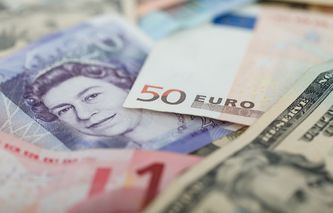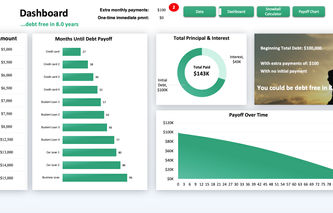Is a million dollars enough to retire on these days? How much interest would you earn per year on $1 million? And what about per month? Will it last for the rest of your life? Or will you run out of money before you die?
These are all important questions. Lucky for you, we'll answer all these questions (and more) in this short read.
If you like this article, check out the interest earnings within the posts listed below:
And take a serious look at our Best Investment Apps piece if you're looking to invest.
What is the Annual Interest on 1 Million Dollars?
With a 5% interest CD (Certificate of Deposit), your annual interest earned on $1 million would be $50,000. If you're seeking higher returns, you could invest in the S&P 500 and likely earn $100,000 per year in interest (based on the 10% historical annual returns).
The interest rate changes depending on where you put your money—a certificate of deposit may earn you 5% a year, real estate may fetch returns as high as 8%, and investing in cryptocurrency once gave you an earth-shattering 1,576% return.
Of course, this isn’t set in stone—factors like how much you invest, the risks you take (as well as pure luck) can drastically affect your returns.
Read on for all the deets on how to make the most of it—
What is the Monthly Interest on 1 Million Dollars?
With a 5% interest CD, your monthly interest earned on $1 million would be $4,167. If you're looking for better returns, you could invest in the S&P 500 and likely earn $8,333 per month (assuming the historical annual return of 10%).
Expected Interest Earned By Investment Type (Yearly and Monthly)?
How about we break it down to see how much interest does 1 million dollars earn per month or a year with various investments?
(And, planning for the long haul, how much interest does 1 million dollars earn per year after 20 years?)
These figures should give you a rough idea—
INVESTMENT OPTION | EXPECTED INTEREST RATE | POTENTIAL EARNINGS IN A MONTH | POTENTIAL EARNINGS IN A YEAR | POTENTIAL EARNINGS IN 20 YEARS |
Cryptocurrency | 5%–95% | $4,166–$79,166 | $50,000–$950,000 | $1,000,000–$19,000,000 |
Stock market | 10%–12% | $8,333–$10,000 | $100,000–$120,000 | $2,000,000–$2,400,000 |
Mutual funds | 10%–12% | $8,333–$10,000 | $100,000–$120,000 | $2,000,000–$2,400,000 |
Index funds | 8%–10% | $6,666–$8,333 | $80,000–$100,000 | $1,600,000–$2,000,000 |
Real estate | 6%–8% | $5,000–$6,666 | $60,000–$80,000 | $1,200,000–$1,600,000 |
Bonds | 4%–9% | $3,333–$7,500 | $40,000–$90,000 | $800,000–$1,800,000 |
Solo 401(k) | 3%–8% | $2,500–$6,666 | $30,000–$80,000 | $600,000–$1,600,000 |
Certificates of deposit | 2%–3% | $1,666–$2,500 | $20,000–$30,000 | $400,000–$600,000 |
High-yield savings accounts | 2%–3% | $1,666–$2,500 | $20,000–$30,000 | $400,000–$600,000 |
Interested in becoming wealthy? The year 2023 was a good one for Yieldstreet and Crowdstreet for passive income. Here's our Crowdstreet review if you're interested.
How to Invest a Million Dollars to Live Off the Interest: 9 Smart Investment Options
From the most stable investment routes to more volatile options—let’s look at all the details:
1. Cryptocurrency
INVESTMENT OPTION | EXPECTED INTEREST RATE | POTENTIAL EARNINGS IN A MONTH | POTENTIAL EARNINGS IN A YEAR | POTENTIAL EARNINGS IN 20 YEARS |
Cryptocurrency | 5%–95% | $4,166–$79,166 | $50,000–$950,000 | $1,000,000–$19,000,000 |
Cryptocurrency refers to any digital currency where cryptography is used to verify and record transactions.
In more ways than one—investing in crypto is like rolling a dice.
What does that mean? Here are two popular 2023 predictions for crypto—
Investing in Ethereum can give you 1,000x returns—the company is also expected to surpass Bitcoin’s market value soon.
The complete failure of FTX may not be an isolated incident—with the audit firm Mazars halting work with all its crypto clients (a major red flag), more cryptos may follow.
So, 1,000x growth or a major loss—there’s no telling where your one million dollars will land.
Apart from volatility, David Kemmerer, CEO at CoinLedger, also warns about security issues, “Cybersecurity is a big threat to any crypto investment. The landscape is marred with instances of fraud and security breaches. You must know how to secure your investments with hardware wallets. Centralized exchanges are also a big threat to digital assets. Such platforms leave your assets vulnerable to hacking and theft. Other security threats include malware, phishing attempts, and the lack of proper regulations.”
Um, so why is crypto even on our list?
Here’s the thing—the 1,000x growth (aka your highest interest rate investment) is still very much possible—so consider investing a small part of your million dollars to get started.
Interested in crypto?
Check out our list of best crypto apps.
Bitcoin IRA is also a great option for newbies—the world’s first cryptocurrency IRA platform lets you self-trade crypto anytime, anywhere (so you can take action right when the market moves).
2. Stock market
INVESTMENT OPTION | EXPECTED INTEREST RATE | POTENTIAL EARNINGS IN A MONTH | POTENTIAL EARNINGS IN A YEAR | POTENTIAL EARNINGS IN 20 YEARS |
Stock market | 10%–12% | $8,333–$10,000 | $100,000–$120,000 | $2,000,000–$2,400,000 |
Not enough people are investing in stocks—in fact, the wealthiest 10% of Americans own over 89% of all US stocks.
Are you on the wrong side of the court? Start investing now.
Consider these options—
Individual stocks let you invest in particular companies that you might be eyeing—this means you have complete control over where your money goes. (Top Wall Street analysts recommend stocks like Papa John’s, Alphabet, and Verizon for 2023.)
ETFs: Don’t know which company to invest in? Check out Exchange-Traded Funds (ETFs). Large-cap ETFs track broad market indexes—so you can invest in the largest companies in America. (Check out Vanguard Information Technology ETF (VGT), Invesco Solar ETF (TAN), VanEck Retail ETF (RTH), and more.)
Dividend stocks are a good lower-risk investment. They give you two sources of returns—regular dividend payments and the stock’s actual value. (Check out expert favorites like First American Corp. (FAF), JPMorgan Chase & Co. (JPM), and others.)
If you're ready to hop into investing, check out our recent post on the best stock apps.
(An interesting study by Hartford Funds says choosing stocks that offer the highest returns may not be a wise move. You want to also look at factors like growth potential and dividend payout ratio.)
Don’t have time to research stock options? Use an investment ratings platform like Morningstar or a Robo-advisor like SoFi Automated Investing.
3. Mutual funds
INVESTMENT OPTION | EXPECTED INTEREST RATE | POTENTIAL EARNINGS IN A MONTH | POTENTIAL EARNINGS IN A YEAR | POTENTIAL EARNINGS IN 20 YEARS |
Mutual funds | 10%–12% | $8,333–$10,000 | $100,000–$120,000 | $2,000,000–$2,400,000 |
You can use these professionally managed portfolios of stocks, bonds, and other securities to diversify your investments.
Mutual funds aim to outperform the market—so they’re less predictable and riskier than options like index funds.
Yet it turns out that mutual funds gave an average annualized return of 11.54% in 2021 — making them an attractive investment opportunity.
Consider investing in some of the biggest mutual funds, including Vanguard Total Stock Market Index Fund Admiral Shares (VTSAX), Fidelity Government Cash Reserves (FDRXX), Fidelity 500 Index Fund (FXAIX), and the like.
4. Index funds
INVESTMENT OPTION | EXPECTED INTEREST RATE | POTENTIAL EARNINGS IN A MONTH | POTENTIAL EARNINGS IN A YEAR | POTENTIAL EARNINGS IN 20 YEARS |
Index funds | 8%–10% | $6,666–$8,333 | $80,000–$100,000 | $1,600,000–$2,000,000 |
Index funds are mutual funds or ETFs that build portfolios to match certain market indexes (such as the S&P 500 or Dow Jones Industrial Average).
Buying an index fund gives you access to a broad range of holdings.
These funds also tend to have low management fees—meaning more money goes towards investing.
Consider investing in major S&P 500 funds, like Vanguard S&P 500 ETF, iShares Core S&P 500 ETF, and SPDR S&P 500 ETF Trust.
Keep in mind that these indexes are set portfolios—so you’ll have no control over the individual holdings. (This is why Index investing can leave you completely vulnerable in a market downturn.)
5. Real estate
INVESTMENT OPTION | EXPECTED INTEREST RATE | POTENTIAL EARNINGS IN A MONTH | POTENTIAL EARNINGS IN A YEAR | POTENTIAL EARNINGS IN 20 YEARS |
Real estate | 6%–8% | $5,000–$6,666 | $60,000–$80,000 | $1,200,000–$1,600,000 |
A study by the Federal Reserve Bank of San Francisco and the University of California revealed that real estate had offered the highest returns of any asset class over the last 145 years.
Now you know why experts swear by investing in real estate.
Should you then shell out your million bucks and buy the biggest house on the block?
You could―but there are other investment choices:
Investing in REITs (Real Estate Investment Trusts): These companies own commercial real estate properties—like retail spaces, office buildings, apartments, and hotels. REITs (modelled after mutual funds) let you invest in real estate without becoming a landlord—so you get to have your cake and eat it too.
Sounds great, but you’re not sure where to begin?
Start investing with a reputed crowdfunding platform like Fundrise. It has a real estate portfolio of over $7 billion—and claims to have provided its clients with average annual returns of 5.40% in 2022.
Invest in fractional real estate: You’ll own a small portion of expensive real estate properties. Consider using online real estate investing platforms like CityVest and Arrived Homes to fund developers looking to finance their projects.
Flip real estate: House flipping can be lucrative. You can buy an under-priced house, renovate, remodel, ikeanize it—and resell it for a profit.
Consider rental properties: The iGMS Annual Forecast Report says the short-term rental market saw a 21% increase in demand in 2022. If you’ve ever dreamed of owning a vacation rental—now is the time to buy a property and convert it.
Rent out a room: Whether you own a house or a spare room—consider renting it out to long-term tenants or pre-screened renters on platforms like Airbnb.
The opportunities with real estate are endless—but keep in mind that investing in real estate means you’re locking away your cash for a bit—so be prepared to deal with limited liquidity.
Also, for some real estate investment platforms you need to be an accredited investor—which comes with income requirements (yeah, you’re a millionaire—but it doesn’t hurt to know).
6. Bonds
INVESTMENT OPTION | EXPECTED INTEREST RATE | POTENTIAL EARNINGS IN A MONTH | POTENTIAL EARNINGS IN A YEAR | POTENTIAL EARNINGS IN 20 YEARS |
Bonds | 4%–9% | $3,333–$7,500 | $40,000–$90,000 | $800,000–$1,800,000 |
These investment vehicles let governments and private companies raise money—while you get paid with interest over a period of time in return.
You can choose from:
Corporate bonds—issued by companies raising money for expansion or development. These high-yielding bonds are taxable.
Municipal bonds—issued by the state raising money for public projects like hospitals, schools, or roads. These (generally low-yielding) bonds don’t attract federal tax—so you can pocket all the gains from the interest. Invest in obligation municipal bonds to fund non-revenue-generating projects (like playgrounds)—and revenue municipal bonds to fund revenue-generating projects (like highways).
Treasury bonds (or T-bonds) are risk-free investments issued by the US government. They are exempt from state and local taxes—but you’ll have to pay federal tax.
(Mind you, bond prices and interest rates are inversely proportional. Interest rates are on the rise now—so bond prices are plummeting.)
Still, bonds are still relatively safe investment options—which is why the economist David Rosenberg predicts Treasury bonds will be the best asset class during an impending recession in 2023.
7. Solo 401(k)
INVESTMENT OPTION | EXPECTED INTEREST RATE | POTENTIAL EARNINGS IN A MONTH | POTENTIAL EARNINGS IN A YEAR | POTENTIAL EARNINGS IN 20 YEARS |
Solo 401(k) | 3%–8% | $2,500–$6,666 | $30,000–$80,000 | $600,000–$1,600,000 |
401(k)—the world’s most profitable marathon!
Okay, dad jokes aside—are you missing out on a 401(k) plan because you’re self-employed?
Stop waiting around, and go solo.
A solo 401(k) plan lets a one-person business set up a 401(k) via a brokerage platform—and save up to $22,500 in 2023 (as elective deferrals if you’re under fifty).
As with a traditional 401(k), the investment goal here is typically long-term growth. Investing in it can also give you significant tax deductions. (You can choose to make tax-deductible deferrals or tax-free Roth deferrals.)
Make sure you don’t have any employees (other than your spouse) if you want to qualify for a Solo 401(k)—and keep in mind that you can only withdraw your fundswhen you reach the age of 59.5 (55 in some cases).
8. Certificates of deposit
INVESTMENT OPTION | EXPECTED INTEREST RATE | POTENTIAL EARNINGS IN A MONTH | POTENTIAL EARNINGS IN A YEAR | POTENTIAL EARNINGS IN 20 YEARS |
Certificates of deposit | 2%–3% | $1,666–$2,500 | $20,000–$30,000 | $400,000–$600,000 |
Certificates of Deposits (CDs) are time deposits—so the longer you hold your money in the deposit, the higher the interest rate you earn.
Your money must remain in the deposit for the whole CD term, though—or you’ll lose a portion of your interest earnings.
You may be wondering, “How much interest will I earn per month?”.
Well, the average rate on a jumbo 24-month CD was 0.21% APY in 2021—but you can earn interest rates as high as 5% (depending on the bank and your CD term). And what you make each month can average between $1,666 and $2,500.
When your CD matures, it’s rolled into another CD to continue earning interest—so you want to pick a short-term CD (12 months or less) if you think interest rates may climb in the next few years. (This way your CD can be rolled over into a higher-yielding CD after rates have risen.)
9. High-yield savings accounts
INVESTMENT OPTION | EXPECTED INTEREST RATE | POTENTIAL EARNINGS IN A MONTH | POTENTIAL EARNINGS IN A YEAR | POTENTIAL EARNINGS IN 20 YEARS |
High-yield savings accounts | 2%–3% | $1,666–$2,500 | $20,000–$30,000 | $400,000–$600,000 |
We’re pretty sure you’ve also wondered, “How much interest do banks pay on 1 million?” or, in other words, “How much interest does a savings account earn?”.
Tip: If you want to save some cash as is, let it sit in a high-yield savings account. This way you invest in a virtually risk-free bank account—and earn more interest than regular savings accounts.
Some of the best high-yield savings accounts are now offering up to 5% interest rates.
You’ll also have easy access to your funds (except for bank withdrawal limits).
Before picking a savings account, make sure you check:
Minimum deposit amount.
Annual percentage rates.
Minimum balance amount.
Withdrawal options.
FDIC insurance (protects a maximum of $250,000 per depositor).
Keep in mind that interest rates on high-yield savings accounts can fluctuate—so an advertised high annual percentage yield (APY) probably won't last forever.
Up Your Money Game With These Top Investment Podcasts
Pick Up Your Reading Glasses For These Brilliant Investment Books
Can I Live Off Interest on a Million Dollars? (Sustainable Withdrawal Rates Explained)
We’ve done the math—and it’s safe to say now you have an idea of the annual interest on 1 million dollars.
But you’re not just looking for numbers, are you?
You’ve saved up a million dollars—and you might want to retire and draw funds over (hopefully) a long time.
What you should be curious about is the sustainable withdrawal rate—the percentage of your savings you can take out for living expenses each year without ever exhausting your funds.
Experts agree about a 4%–5% withdrawal rate—but it’ll depend on a few factors:
Your annual spending.
Length of your retirement.
Inflation rates.
Rates of return on your investments.
A lot of these are out of your control—except how much you choose to spend each year.
I have been a long-time fan of Mr. Money Mustache—who rightly points out that if you can ratchet down your expenses now, no matter what your age—you’ll reap double the benefits in retirement.
Cutting down on your spending will leave you more funds to save—meaning more money for when you’re retired.
Monthly Withdrawals on 1 Million Dollars for a Sustainable Retirement
A million dollars is a decent amount of money if you’re retiring in the next few years—you’ll likely survive quite nicely.
But let’s look at more specific examples of your safe withdrawal rate if you think about the interest on one million dollars in your 401(k)—
Generous retirement example
One million dollars starting balance at a 4% rate of return.
30-year retirement (a pretty lengthy one).
$55,000 withdrawal per year.
A compound interest calculator will tell you you’d still have $63,000 left in your account by year 30.
It’s not an insanely cushy retirement—but it’s certainly not a shabby one (especially if you entered retirement completely debt-free).
(Not debt free? Try out our debt snowball template to see how quickly you could get out of debt.)
Frugal retirement example
One million dollars starting balance at a 4% rate of return.
30-year retirement.
$30,000 withdrawal each year.
We’re taking frugal seriously here by cutting your spending in half—but keeping everything else the same.
Now you’ll be left with over $1.5 million after 30 years, enabling you to live a decent lifestyle in retirement—and even leave a robust inheritance.
Super-early retirement example
One million dollars starting balance at a 4% rate of return.
A whopping 50-year retirement.
$30,000 annual withdrawals.
Guess what? You’ll end up with $2.5 million even after 50 years of retirement.
We get it—your spending wouldn’t stay exactly at $30,000 every year in early retirement.
Then look at the interest on $2,000,000 or $500,000—and play around with scenarios of working until 60 or 70.
(Is $30,000 sounding too low? Maybe $40,000 is a good middle ground?)
The idea here is to toy with the numbers until you arrive at a realistic retirement plan that suits you.
Can You Live Off The Interest of 1 Million Dollars?
So, what’s the real answer here?
Can you retire off the yearly interest on 1 million dollars? Or should you hold off and keep saving?
“Winter is here”—and so is the inflation rate. One million dollars isn’t as much as it used to be.
Based on the examples we outlined above, if you retire at 65 and live for 30 years, you can really only withdraw $55,000 a year. (Any more than that and you’re at risk of running out of money.)
Bottom line: If you don’t want to live large in retirement, then one million dollars is mostly fine—but if you’re interested in boating, traveling, or hosting lavish parties—you might want to shoot for more before you pull the trigger on retirement.
What is the interest on $1.5 million a year?
It might be a stretch, but what if you could bump up your nest egg up by $500,000?
With the same assumptions (4% return rate and a 30-year retirement), you could withdraw $80,000 a year and still have $242,000 after you passed away—not too bad.
(Related: How much interest does 2 million dollars earn per year? And: What’s the interest on 1 billion dollars?)
Key Takeaways
The interest on your million dollars can change depending on where you invest it—a high-yield savings account may earn 2% a year, stocks may fetch returns as high as 12%, and investing in crypto can give you average returns of 95%.
Figuring out your sustainable withdrawal rate is key—this is the percentage of savings you can withdraw for living expenses each year without ever exhausting your funds.
Experts recommend a 4%–5% withdrawal rate—but your withdrawals can depend on your annual spending, length of your retirement, inflation, and investment returns.
Play around with numbers and a compound interest calculator to figure out if you want a generous, frugal, or early retirement.




.jpg)


